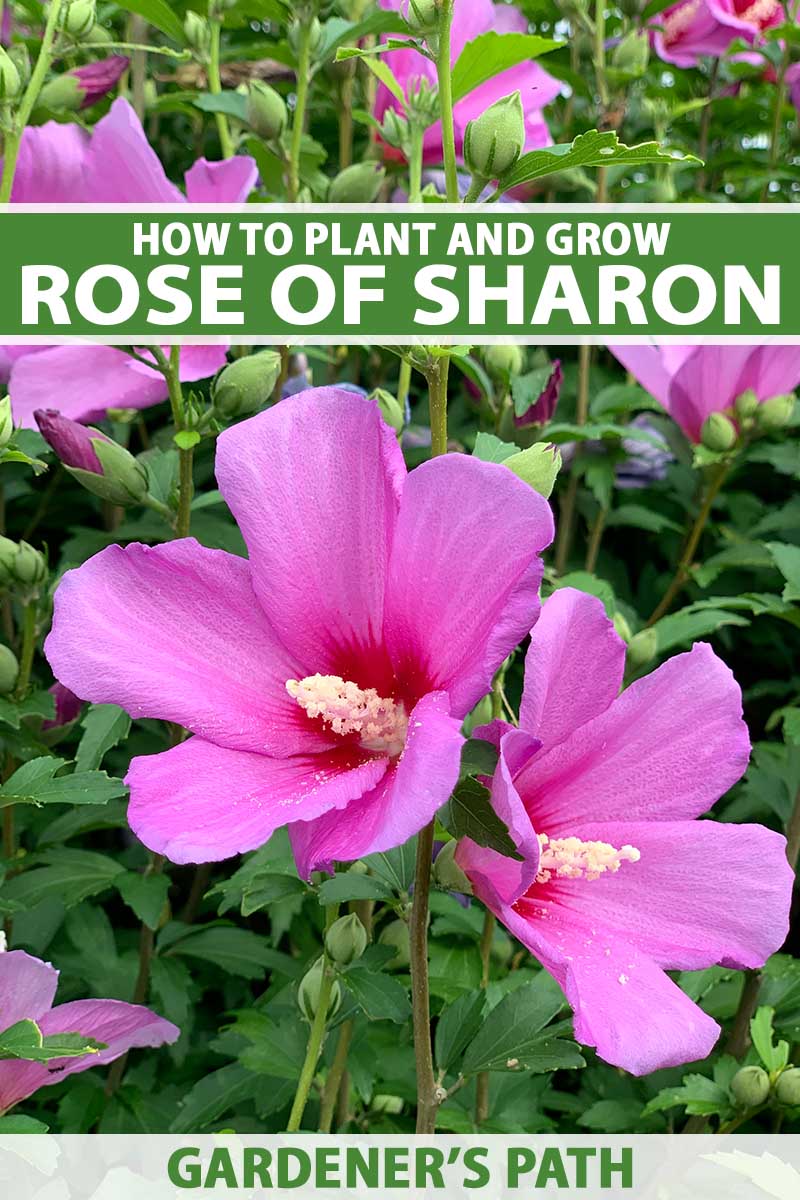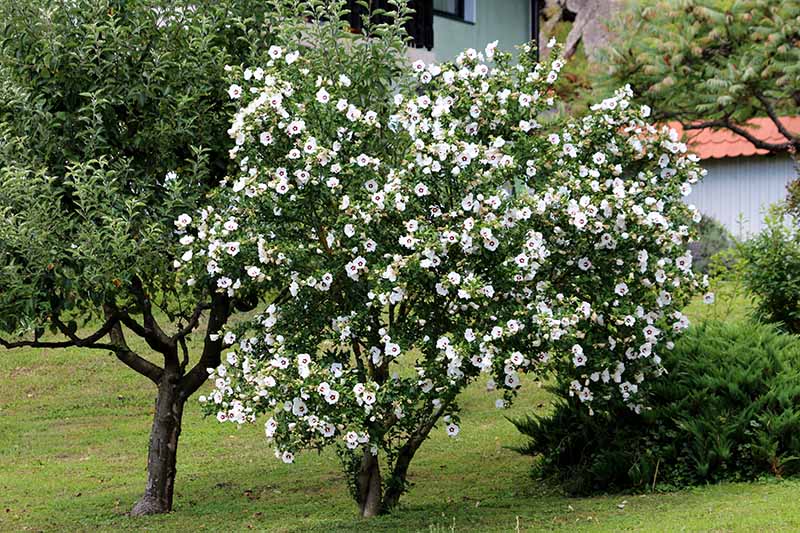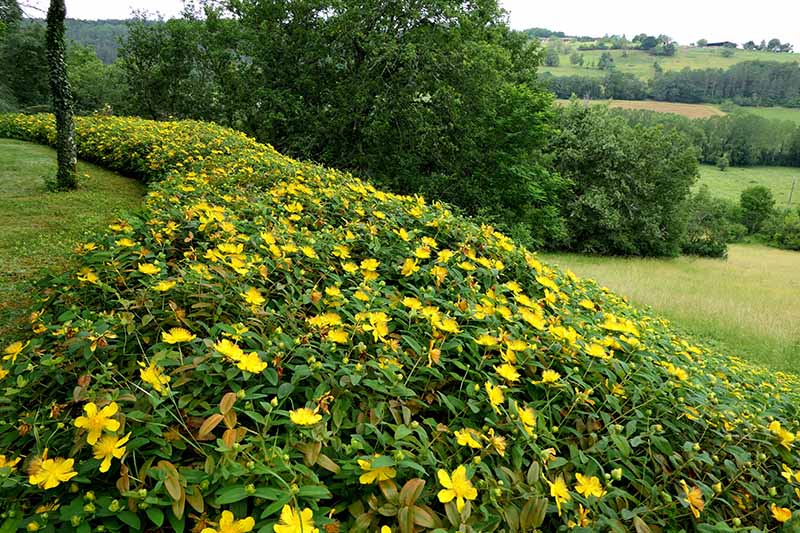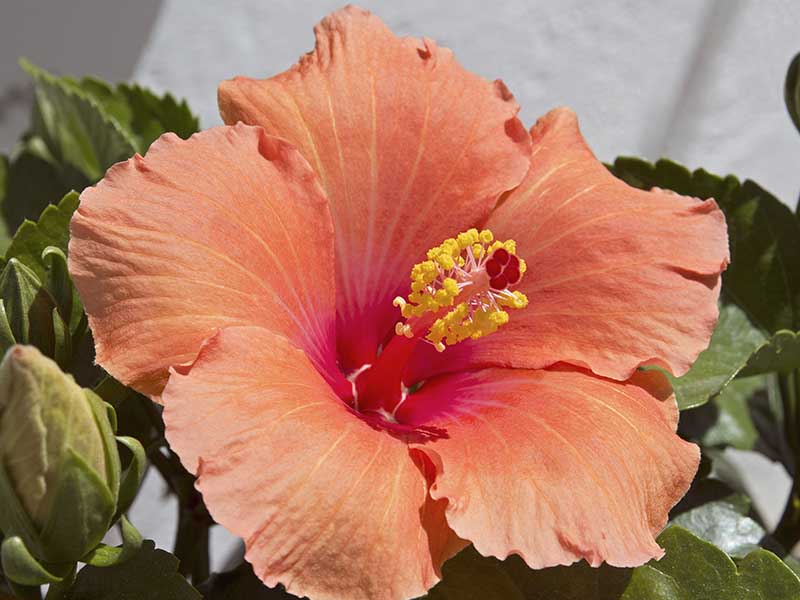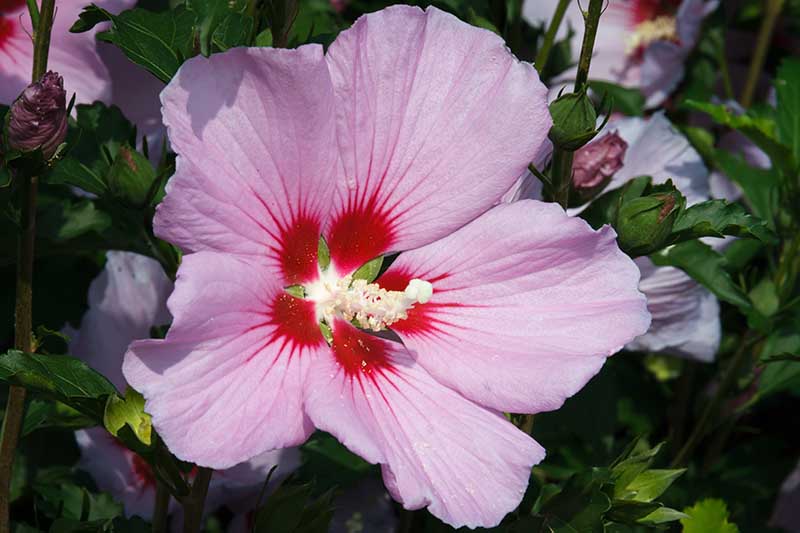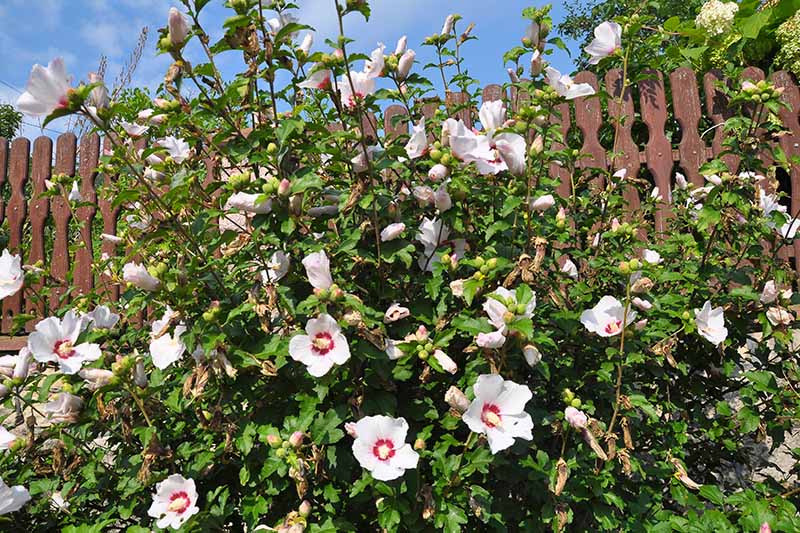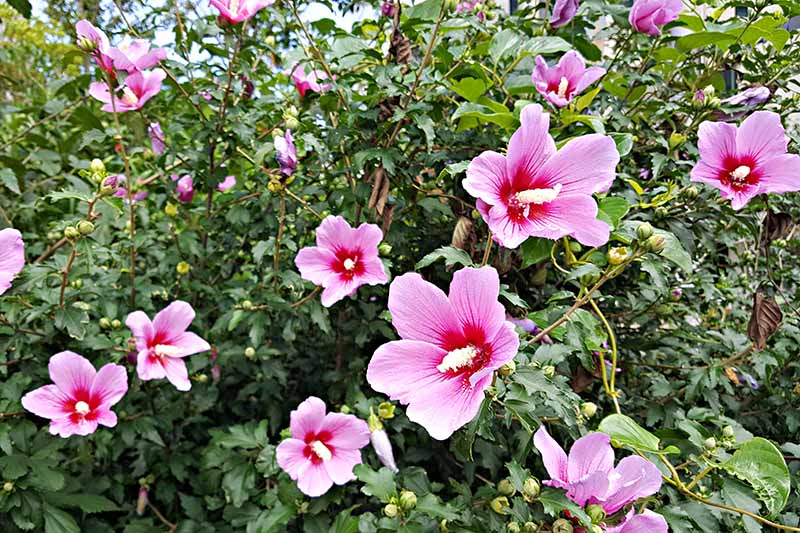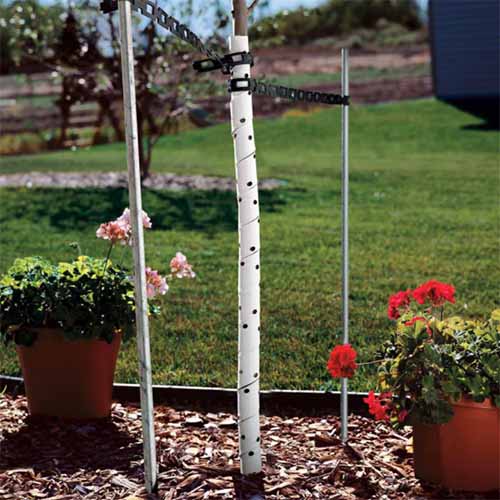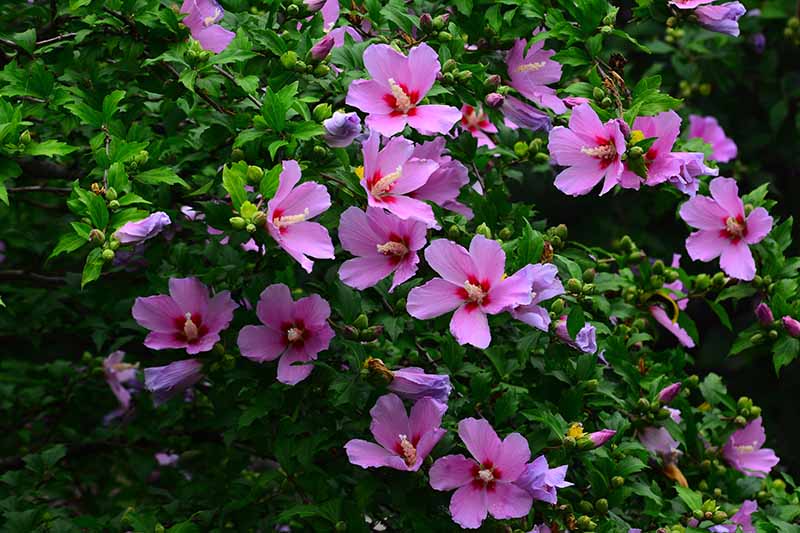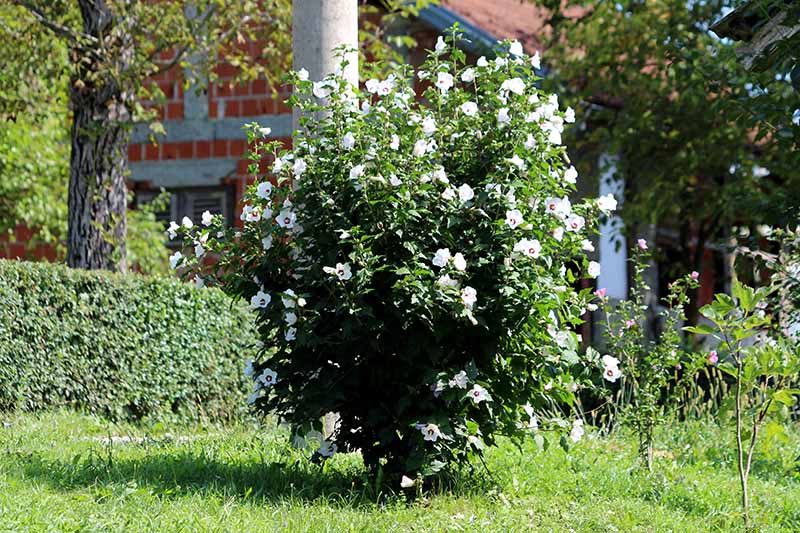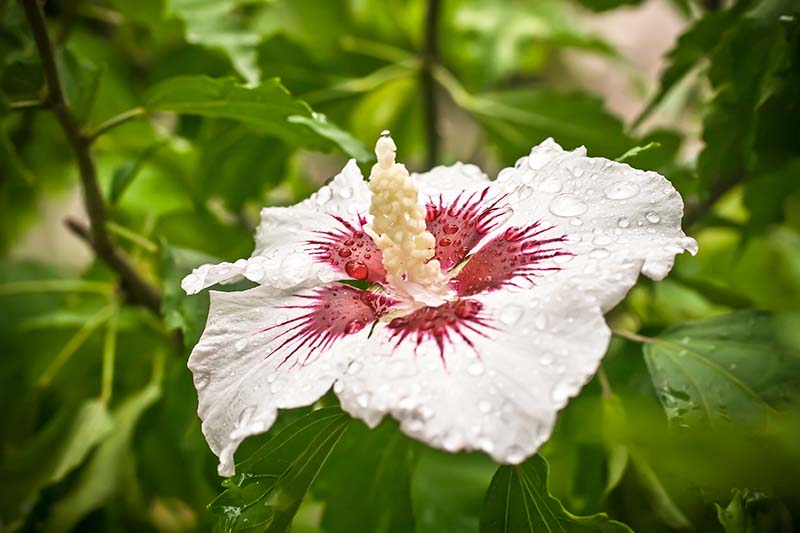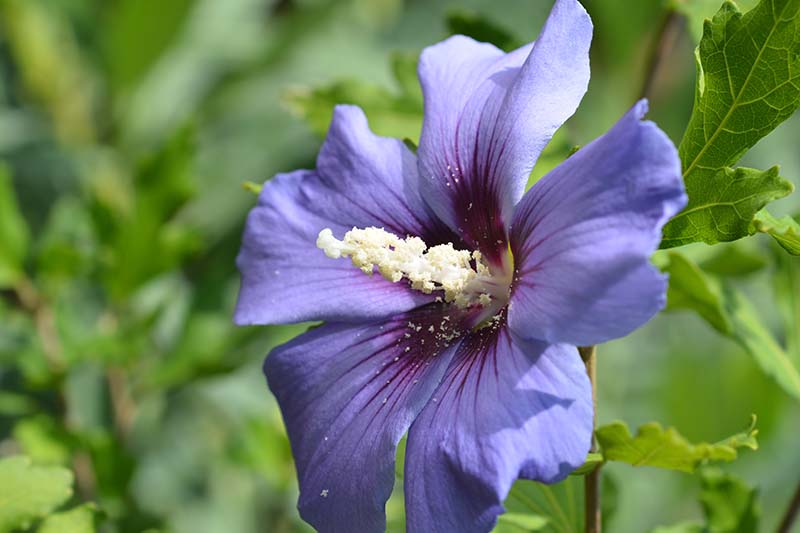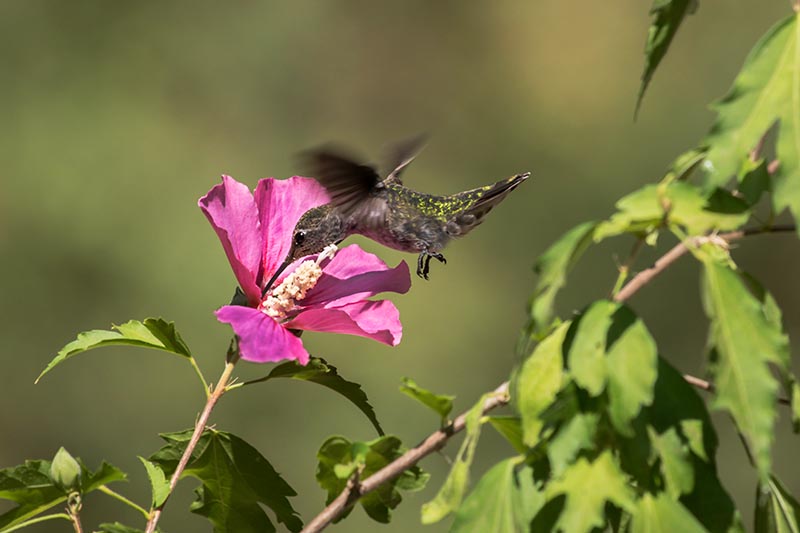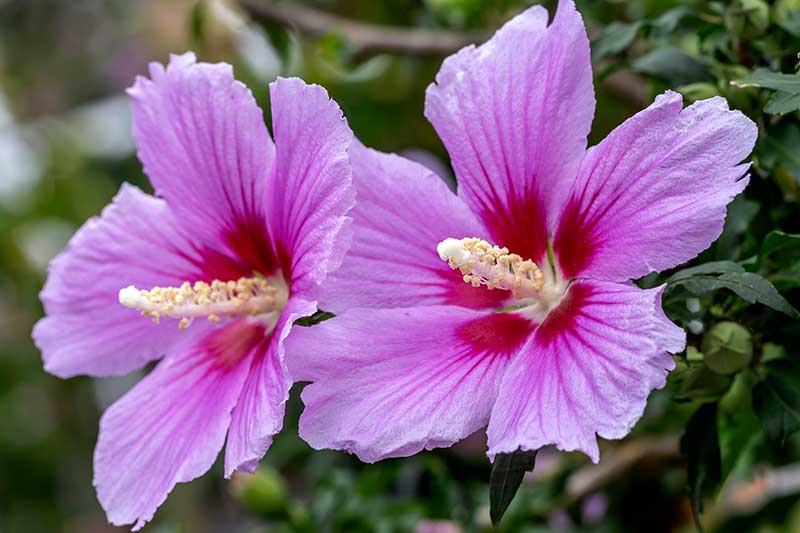Flowers are purple, pink, white, red, fuchsia, or combinations thereof, and are usually between three to six inches in diameter, depending on the cultivar and growing conditions. We link to vendors to help you find relevant products. If you buy from one of our links, we may earn a commission. Other plants in this family include hardy hibiscus (H. moscheuto and other rose mallows) and the popular tropical hibiscus (H. rosa-sinensis).In this growing guide we’ll explore some tips to get your plants started, how to keep them healthy, and how to maintain vibrant blooms. Then we’ll review a few top-pick cultivars ranging in height from three to 16 feet, with a variety of flower colors available. Here’s what I’ll cover:
What Is Rose of Sharon?
Rose of Sharon, sometimes called shrub althea, or hardy hibiscus (not to be confused with the aforementioned rose mallows that also go by this common name), is an indispensable addition to any garden. Suitable for growers in USDA Hardiness Zones 5 to 9, they may need to be protected for the first couple of winters in Zone 5 until they become established, and should be planted in a sheltered location in Zones 5 and 6. Uniquely attractive, these multi-stemmed shrubs bloom late in the season from midsummer onward, after many other perennials have already finished flowering. They provide fall beauty as well as late season food for pollinators such as bees, butterflies, and hummingbirds.It’s a little-known fact that the young leaves of the plant are edible, either raw or cooked. They tend to get tougher by the end of the summer, but I find them quite mild in flavor, and acceptable as part of a salad earlier in the season – an important selling point for food gardeners such as myself who wish to fill the garden with edibles rather than solely ornamental plants. Hypericum calycinum, also known as rose of Sharon or Aaron’s beard, is a low-growing yellow flowered shrub in the Hypericaceae family. Though this species may share the same common name, it’s hard to mistake it for H. syriacus if you know what you’re looking for. Note that the leaves of H. calycinum are not known to be edible.While many other types of flowering shrubs are still becoming established, rose of Sharon matures with a flush of blooms at two years old, with flowers forming on new growth. The shrub establishes quickly in warmer climates, but can be a bit slower to get going in Zones 5 and 6.Speaking of slow starts, the medium-green, three-lobed leaves of H. syriacus don’t appear until late May or early June each year, so don’t assume your plant is a goner based on its lack of early spring greenery.
Cultivation and History
Rose of Sharon is native to China and possibly other areas of East Asia as well. It is held in high regard as the national flower of South Korea. Historically, it was used in China as both food and medicine. The flowers are referred to as mu jin hua in traditional Chinese medicine, used most popularly as a longevity-promoting tea. Other medicinal applications include use as a treatment for abdominal pain, diarrhea, and ringworm.
Propagation
H. syriacus is easy to propagate from seed, or by transplanting seedlings from the nursery. You can also start new plants by layering branches, or rooting stem cuttings. By layering or taking cuttings, you’ll get a clone, or a plant that’s identical to the parent plant. Hybrid cultivars may not grow true to seed.
Transplanting
A good starting point if you’re looking to propagate plants is to look around and under existing plants, if you have access to any, to see if any small seedlings are coming up. If you do find some small seedlings and you want to transplant them into your own garden, simply dig them up, pot each one in a soilless medium in an eight to 12-inch (two- to five-gallon) pot, and care for them as described below until they’re at least one to two feet tall. Plant them out in the early fall, or in early spring after all danger of frost has passed. Keep reading for site preparation and planting details.
From Cuttings
There are a few possible methods of taking rose of Sharon cuttings. These include rooting hardwood cuttings, softwood cuttings, and semi-ripe stem cuttings. Cuttings can be taken and placed directly in nursery beds or in pots.I’ll focus on my favorite method below: semi-ripe stem cuttings rooted in a controlled environment such as a greenhouse or indoors. Take cuttings in the summer, in July or August, before the new growth on the ends of branches becomes woody. Branches are ready to cut for semi-ripe propagation when they are still green at the tips, and just beginning to harden.Select branches that are roughly the thickness of a pencil, and take five- to six-inch cuttings at a 45-degree angle directly below a bud. Remove all but the top two to three pairs of leaves. Not all cuttings will root, so take three times more cuttings than you want plants.Prepare four- to six-inch pots of moistened soilless potting mix, and poke holes into the center of the mix, slightly wider than the cuttings. I recommend using semi-softwood rooting hormone powder or gel containing at least 0.4 percent indole-3-butyric acid (IBA) for rooting H. syriacus cuttings, such as Stim-Root No. 2 Rooting Hormone Powder. Remove a small quantity from the container and place it in a small dish or paper cup to use for this gardening project. You want to avoid contaminating the whole container of rooting hormone with your cuttings. Moisten the bottom half of each cutting, and dip it in the rooting hormone. Carefully place the cuttings into the holes in the medium in your prepared pots, to a depth of about three inches (half of the stem length). Tamp down the soil mix around the stems.Cover the pots with clear bags or planter humidity tops. Prop the bags up away from the cuttings, using three or four popsicle sticks stuck into the soil. Check regularly and make sure the potting medium stays moist, but not oversaturated. Water with three percent hydrogen peroxide for about a quarter of the waterings to keep the cuttings from rotting. Keep them in a bright location with indirect light until roots appear through the bottom of the pots. Then remove the bags and transition them gradually to full sun. Your cuttings can be kept outdoors or indoors, though their growth will slow if temperatures drop below 70°F. It’s best to keep them indoors or in a greenhouse for their first winter if growing in cooler areas like Zone 5.When plants reach 12 inches tall, transplant to eight to 10-inch-wide pots. Continue to water regularly to maintain soil moisture and fertilize once per month with a balanced product for flowering plants. If all goes well, the plants should grow to at least 16 to 24 inches through the winter and will be ready for planting in the spring.
Layering
Layering is a method of rooting branches while they are still attached to the parent plant. This can be done in midsummer to early fall. Simply bend healthy-looking lower branches down to the ground and dig them into the soil at least three inches deep. Cover at least six inches of the length of the branch, and leave at least five inches of the end sticking out of the soil. If needed, you can place a rock on top to keep the branch in place in the soil. In early spring, you can gently dig away the soil. If roots have formed that are at least three inches long, cut the branch off from the parent plant just above where the roots have formed, and remove the new plant for transplanting.If roots haven’t formed yet, bury the branch again and check once a month for the next couple of months until roots form. New plants should ideally be transplanted only in the spring or fall. Otherwise, you’ll need to pot them up, bring them indoors or into a greenhouse in full sun, and wait to transplant out to the garden until the following planting season.
From Seed
Since rose of Sharon doesn’t grow true from seed – in other words, plants may not be anything like their parents in terms of flower color or size – growing them from seed that you’ve saved can be a good way to get some variety. I also find plants grown from seed are more vigorous, with healthier root systems. Seeds aren’t commonly available from plant nurseries. And some cultivars don’t produce seed at all. To harvest your own seeds from mature plants, wait until the seed pods are brown and dry in the fall. Harvest the pods, remove the seeds, and place them in a zip-top sandwich or freezer bag in the fridge with a piece of tissue to absorb excess moisture. This will keep them fresh.Two months before your expected last frost date, or one month before planting out in frost-free areas, start seeds indoors in four-inch pots filled with moistened soilless potting or seed starting mix. Sow seeds a quarter to half an inch deep. If you have enough seeds, plant three per pot to better ensure that each produces a plant.You may place the pots in a heated greenhouse or in plastic bags to increase humidity and heat retention, to boost germination rates and speed. Keep soil temperatures between 75 and 82°F, and germination should occur within two to four weeks. This can be done using a heat mat or by placing them in a sunny window. Maintain the moisture of the growing medium, but do not allow it to become waterlogged. If the temperature goes above the recommended range, move them away from the window and partially close the shades or curtains. If you are growing in a greenhouse, make sure it is well ventilated, and use shade cloth as needed to keep temperatures in the correct range. Once seeds germinate, remove the bags. When seedlings are one to two inches tall, thin them out to keep only the strongest seedling in each pot. Fertilize them weekly with a balanced fertilizer until the end of June in Zones 5 and 6, and up to mid-July in warmer locations. If you like, seedlings can be hardened off and moved outdoors for the summer, or kept inside. They should then either be planted out in the early fall, or brought indoors or into a greenhouse before planting them out in early spring, after the last frost. You can also plant them right away in their first spring when they are a few inches tall if you diligently protect them from weeds and nurture them carefully. If you choose to do so, mulch well and baby them by keeping the soil evenly moist. Using a small spiral or plastic tube tree guard to shield them from rodents and deer is also a good idea. I buy larger ones and then cut them to size. Tube Tree Guard Give this one a try, available from Home Depot. In Zone 5, winter protection will increase their chances of survival, which can include either wrapping them in burlap or using plant shelters. Remove burlap in early spring before they leaf out.
How to Grow
Rose of Sharon requires full sun and a sheltered location, especially in colder climates. Ideally, soil should be humus-rich and fertile, but H. syriacus can grow in sandy or clay soils as well. Plants require good drainage and can’t tolerate wet feet. They can, however, tolerate pollution and salt, so they’re perfect for gardeners in urban or coastal areas. Apply four to six inches of chipped wood mulch or pine straw every spring to cover their roots at least out to the drip line – the outer perimeter beneath the canopy of the branches. This will help to keep the plants cool and moist. Avoid applying any right up against the stem to avoid rot.According to Professor Alex Niemiera of the School of Plant and Environmental Sciences at Virginia Tech, the plants prefer a soil pH level between 3.7 and 7.3. The soil should also be kept evenly moist for best results. Sandy soil in particular should be amended with compost at least biannually to increase quantity of organic matter and aid water retention. Unlike some flowering plants which gobble phosphorus, H. syriacus has moderate nitrogen (N), low phosphorus (P), and high potassium (K) needs when mature. If your soil is lacking in overall fertility, a slow-release fertilizer meant for use on trees or woody shrubs with these NPK levels should be applied in late winter or early spring. Fertilizing later in the season can cause plants to put on new growth that doesn’t have time to harden off before winter. As with any plant, you should be aware of your soil’s nutrient levels before indiscriminately fertilizing. This is especially true for rose of Sharon, which is susceptible to overfertilization. Too much nitrogen may cause the plant to continuously put on new foliar growth without ever flowering. You should always adapt your fertilizer’s nutrient balance based on soil test results. Ideally, soil fertility should be built before planting, though adjustments and additional amendments may be needed after future soil tests. Soil tests can be done every three years, though this may not be needed for hobby gardeners if no problems are evident in your plants.
Growing Tips
Plant in organically-rich, well-draining soil.Choose a full sun location on the south side of a wall, building, or hedge for shelter.Mulch well to keep roots cool and to retain moisture.If you’re in Zone 5, consider protecting the plants in the winter with burlap or keeping them inside for their first year.Protection from cold winter winds is especially important in Zones 5 and 6.
Pruning and Maintenance
Pruning is not mandatory, unless you want to increase flower size or train your shrub to be a single-trunked tree. All pruning should be done in the winter or early spring when the plant is completely dormant to avoid stressing it. In general, very light pruning causes plants to bloom more profusely but with smaller flowers, whereas heavier pruning leads to larger, less abundant flowers.Pruning may need to be done in the first winter if you want to create a tree-like shape. If growth is minimal, you can wait until the second year. If a tree-like habit is your goal, simply cut all but one stem off right down to the ground, choosing a more central leader stem with some side branches. Do this annually to maintain its shape. For lighter pruning, remove only dead or diseased branches. For heavier pruning, cut back one-third of the wood each year, focusing on weak and older branches. Never cut back more than one-third at a time or you risk harming the health of your plant. Read more about pruning ornamental shrubs in this guide. Each branch can be cut back to leave only three buds minimum, though more can be left intact if you prefer to tip the balance a bit more towards producing smaller, more numerous flowers. Diseased or dead branches should be cut back to the ground or the base of the stem. As a side note, you may have to keep a close eye on these plants, as some growers have difficulty controlling their spread via seed in warmer climates. In Zone 5, where I grow them, control of self-seeding has never been an issue. Neglected seedlings don’t seem to do well, and they need to be protected carefully from weeds, cold winds, and temperature extremes to survive.
Cultivars to Select
Rose of Sharon has been in cultivation for thousands of years, and there are a wide variety of cultivars to choose from, with different flower colors, plant shapes, and sizes available.
Managing Pests and Disease
Rose of Sharon may occasionally be bothered by a few pests, particularly if plants are stressed or lack ideal growing conditions. Here, I’ll cover the top culprits. The following are but a few selections to demonstrate the available diversity:
Ardens
‘Ardens’ has three-inch lavender double blooms with a unique ruffled appearance. Leaves are diamond shaped with a vibrant green color and serrated edges. ‘Ardens’ These grow to mature dimensions of eight to 12 feet tall, and six to eight feet wide. Plants are available at Nature Hills Nursery.
Lil’ Kim
‘Lil’ Kim’ is a dwarf cultivar that has showy five-petalled white flowers with wine-red throats that bloom for three days each, an impressive feat compared to the day-long blooms of most varieties. ‘Lil’ Kim’ These plants have dark green, lance-shaped leaves and an upright growth habit. They grow best in Zones 5 to 9, maturing to just three to four feet in height and width.You can find plants available at Nature Hills Nursery.
Magenta Chiffon
‘Magenta Chiffon’ has plentiful, bright magenta double blooms and grows in a rounded shape. It’s known for being less rigid than other varieties, with the ability to blow in the breeze. ‘Magenta Chiffon’ This cultivar reaches a mature height of eight to 12 feet tall and spreads six to 10 feet.Plants are available at Nature Hills Nursery.
Minerva
‘Minerva’ has trumpet-shaped pink to lavender flowers with red throats and yellow stamens that bloom from mid-July until September, or later. It produces few, if any seeds. ‘Minerva’ Plants have glossy green leaves and an upright form reaching eight to 12 feet in height, and a spread of six to 10 feet wide at maturity. You can find plants available at Nature Hills Nursery.
Sugar Tip
‘Sugar Tip,’ aka ‘America Irene Scott,’ has light pink double flowers with creamy-fringed blueish green leaves. ‘Sugar Tip’ It produces no seed and grows eight to 12 feet tall, with a spread of three to four feet at maturity.Plants are available at Nature Hills Nursery.
White Pillar
‘White Pillar’ is known for its upright, pillar-like growth habit, growing to a mature height of up to 16 feet tall, with a spread only two to three feet wide. ‘White Pillar’ Snow-white billowing tissue-paper-like double flowers adorn this variety, which has deep green leaves and thrives in Zones 5 to 9.You can find plants available from Nature Hills Nursery.
Insects
My preferred method of preventing pests from getting out of hand is to encourage beneficial insect populations in my garden, while applying the principles and techniques of integrated pest management. If you do have a serious infestation that needs to be treated, the insect pests described below can usually be controlled with a mixture of insecticidal soap and neem oil. For one liter of spray, mix one teaspoon neem oil with one third of a teaspoon of insecticidal soap or biodegradable dish detergent, and one liter of warm water. Always test your spray on a few leaves of your plant and wait 24 hours to observe if there is any damage. This may appear as discoloration or “burning” of the foliage, wilting, or desiccation.
Aphids
Aphids are notoriously destructive sap suckers that appear on stem tips or leaves. As they feed on the plant, they leave a spotty, sad mess in their wake. They also leave behind a sticky substance called honeydew that traps fungal spores and can contribute to the spread of fungal diseases. Aphids are best controlled with weekly spraying of the mixture described above. See our guide to learn more about how to control aphids in your garden.
Japanese Beetles
Sprays may not be quite as effective for treating these small, metallic green beetles with bronze or copper-brown wings. The telltale sign of a Japanese beetle infestation is skeletonized leaves or flowers.
Whiteflies
Whiteflies are small white flies that, like the closely related aphid, are often found on the undersides of leaves, sucking sap. Beneficial nematodes may be effective, and milky spore, available from Nature Hills Nursery, can also be used to kill the pests in their grub stage from October to March. Milky Spore You can learn more about controlling Japanese beetles in your garden in this guide. Affected leaves will be pale or yellow in color, and they may wilt. Remove and destroy affected leaves. Plants with an infestation should be sprayed at least weekly with the aforementioned mixture.
Disease
The most common diseases that may plague rose of Sharon are leaf spot, rust, and root rot. All are fungal infections that can be treated with copper-based fungicides.
Leaf Spot
Leaf spot appears as circular yellow or brown lesions or spots on foliage, and a worsening problem leads to the eventual loss of leaves. It’s usually caused by Cercospora or Phyllosticta species of fungi. To treat, first remove and destroy all infected plant material. Then, spray the fungicide over the entire plant and the surrounding soil out at least one foot beyond the dripline.Ensure your plants have good air circulation by keeping them well-weeded, and consider pruning to thin out branches and allow for better airflow. Water only at the base of the plant, and keep on top of pruning any dead or diseased branches.
Root Rot
Root rot is caused by various types of fungi and is best prevented by making sure plants have adequate soil drainage. Treatment options are limited, though a suitable fungicide application program may be effective. To learn more about preventing and treating it, check out our in-depth article on root rot here.
Rust
Rust, caused by the fungus Kuehneola malvicola, is a common problem for members of the Malvaceae family and it looks like… well, rust. Orange spots appear on the foliage, usually beginning on the underside of the leaves. Although rarely deadly, rust can be unattractive and it slows the growth of plants. Treat in the same manner as leaf spot, as described above.
Best Uses
H. syriacus are versatile plants that have a number of uses in the landscape, especially given the diversity of varieties available in numerous shapes and sizes. Large varieties are responsive to pruning, so they can fit into any garden.Smaller varieties can be planted in borders, while larger types make effective privacy screens or hedges, and most serve as excellent specimen plants. They can be especially attractive doubled up on either side of an entrance to a garden or patio. With many easy-to-grow varieties of different sizes, and flower colors to fit any garden, the elegance and charm of these abundantly flowering plants should grace every landscape in Zones 5 to 9.With few pest or disease issues, and little effort required to grow them, H. syriacus is an excellent choice for a late season, low-maintenance blooming shrub, with edible leaves to boot! Are you growing rose of Sharon? How does it fit into your garden scheme? Please share in the comments below, and feel free to post a picture! And for more information about hibiscus plants, check out these guides next:
How to Grow and Care for Hardy Hibiscus37 of the Best Hibiscus Varieties
